|
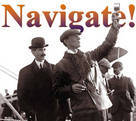
 Up
Up 
 KathArinE
KathArinE
Wright 
(You are here.)
 Down
Down




  Need
to Need
to
find your
bearings?
Try
these
navigation aids:
If
this is your first
visit, please stop by:
Something
to share?
Please:



|
|
Available in Française, Español, Português, Deutsch, Россию,
中文,
日本, and others.
 atharine
Wright was born at the Wright home at 7 Hawthorn Street, Dayton, Ohio on August 19, 1874 -- her brother
Orville's third birthday. She was the youngest of the offspring of Milton
and Susan Wright, and the only girl to survive. (Her only sister Ida died
in infancy.) Like all the Wright children, she had no middle name -- her
father claimed that he gave his offspring distinctive first names so they
wouldn't need middle names. This may be the reason for the unusual spelling
of her name. Her brothers called her by the nickname "Swes,"
an affectionate German diminutive for "little sister." Most of
her friends called her "Kate." atharine
Wright was born at the Wright home at 7 Hawthorn Street, Dayton, Ohio on August 19, 1874 -- her brother
Orville's third birthday. She was the youngest of the offspring of Milton
and Susan Wright, and the only girl to survive. (Her only sister Ida died
in infancy.) Like all the Wright children, she had no middle name -- her
father claimed that he gave his offspring distinctive first names so they
wouldn't need middle names. This may be the reason for the unusual spelling
of her name. Her brothers called her by the nickname "Swes,"
an affectionate German diminutive for "little sister." Most of
her friends called her "Kate."
Woman of the House
Katharine lost her mother to tuberculosis when she was just
a month shy of 15 years old, and the loss devastated her. Milton sensed
that his daughter's grief was especially deep. Never one to council
inaction, he suggested that she might work through her grief by making a
personal memorial to her mother. Her mother had died in mid-summer, and
Katharine began to collect as many different types of flowers and blooms
as she could find in 1889. These she pressed into an album that she
kept with her always.
With her mother gone, Katharine also
inherited new responsibilities. Her father was a bishop and an important leader in the
Church of the United Brethren, and the loss of his wife was a severe blow
not only emotionally but professionally. He was expected to travel a great
deal -- at one point in his career, he was bishop over all the
congregations of Brethren west of the Mississippi River and east of the
Rocky Mountains. When he was
traveling, he relied on his wife to run the household. When he was home,
he entertained church elders, visiting ministers, and other professional
acquaintances constantly. He needed her help; more to the point, he
expected it. Milton had a commanding presence whether he was home or
away. So fifteen-year-old Katharine
stepped into the role of hostess and head of the Wright household.
The three youngest Wright children,
Wilbur, Orville, and Katharine, were especially close. Some biographers
speculate
that at some point in their
youth Will, Orv, and Kate made a pact never to
marry and always stay together. More likely, they simply preferred each
others' company while they were growing up. But once she reached
womanhood, Katharine apparently had her share of gentleman suitors and
admirers. One of aviators whom the Wright brothers taught to fly once
described her as having "coal black hair, deep blue eyes, and a smile
that could blind you." She was very outgoing and comfortable engaging
anyone in conversation, in contrast to her shy and sometimes withdrawn
brothers. Nonetheless, she remained unmarried until she was well into
her fifties, most likely because she felt a sense of duty to her family,
in particular, her father. In that day and age, it was common among
families for one of the younger siblings to remain at home and take care
of their aging parents.
Oberlin
Milton, for his part, apparently felt
that Katharine should have some career training to fall back on when he had
passed on. In 1893 he sent her to college to become a teacher – one of
the few careers available to women in that era. She would become the only one of the Wright
children to earn a college degree.
Katharine attended Oberlin College
in northern Ohio, among the first colleges in the United States to
admit women, and the oldest coeducational college in America. Living
with other women was a life-altering experience for Katharine, who had grown
up in a house full of men. For the first time, she was on an
intimate basis with women her own age and she quickly made several
deep and lasting friendships. One of Katharine's roommates was
Margaret Goodwin, a minister's daughter from Chicago. She was as
exuberant as Katharine and the two became best friends. Kate also
became close to her other roommate Harriet Silliman, as well as Kate
Leonard who lived at home in Oberlin. Kate and Harriet were
much more serious than Katharine and Margaret, but the four seemed
to round each other out and they became a close-knit group.
Katharine's college life wasn't just filled with women, she also
met a few men. Henry J. Haskell, better known as Harry, took his
meals at Katharine's rooming house. Like Margaret, he was the
son of missionaries. Unlike her, he was intensely studious.
Although he was Katharine's same age, he was two years ahead of her
in his studies. He was also a brilliant mathematician, which
Katharine was not. In fact, she required help with her freshman math
courses and Harry tutored her three times a week. They soon became
fast friends.
Despite her troubles with math, Katharine excelled at most of her
studies, in particular Latin and Greek. In the late nineteenth
century, both high school and college courses were divided into
"information" subjects such as history and physics and "training"
subjects such as the classic languages (Latin and Greek) and
mathematics. The educational theory of the day was that training
subjects exercised the mind, helping to develop mental powers and a
refined character that would serve a person well in all other
endeavors. Katharine found herself studying to become a teacher of
classic languages.
It was customary in Oberlin, as at other coed colleges, for the
men and women to pair off during their senior years. Harry Haskell,
for example, proposed to one of Katharine's housemate's, Isabel
Cunningham. Katharine, however, was out of romantic circulation for
much of her senior year – she had become engaged much earlier. In
1896 at the end of her sophomore year a senior classmate, Arthur Cunningham,
had proposed to marry her when she finished her degree. Arthur graduated Oberlin
that spring, went off to
study medicine in nearby Cleveland, and whatever romance there had
been cooled. When Katharine suggested that they give it up in 1898, he
seemed relieved. Afterward, she referred to the affair as "my narrow
escape." Her father, Milton, never knew that she had been engaged.
Katharine graduated from Oberlin in June of 1898
– it had taken five years to complete her
degree. This was partly because she had missed some of her junior
year. In the early fall of 1896 Orville had come down with typhoid
fever and Katharine had stayed home to help nurse him. Once she had
her diploma, she applied
for, but did not get, a teaching position in Dayton's Steele High
School. Her friend Margaret had better luck, landing a
teaching position in Dover, OH. Harry Haskell started as a cub
reporter with the Kansas City Star. But it took a year for Katharine
to secure a position as a substitute teacher. She began her teaching
career in 1899, the same year that her brothers began their aviation
experiments in earnest.
Veni, Vidi, Volavi*
Upon return from Oberlin, Katharine
also resumed her position as head of the
Wright household, although she hired a maid, 14-year-old Carrie Kayler
(later Grumbach), to help with
cooking and cleaning. By all accounts, Katharine was a taskmaster, riding
Carrie hard and none to gentle with Orville and Wilbur. In many
ways, she had grown up to be her father's daughter, commanding and
authoritarian. At the beginning of one school year, Orville asked her for a list of "the first week's victims" among her pupils.
"I like to see someone else catch it besides us," he explained.
Katharine managed to transplant some of the
rich social life she had enjoyed in college to Dayton. Suddenly
there were parties and bicycle outings and camping trips originating
at 7 Hawthorn Street. Occasionally Margaret or Harriet would come to
visit, but for the most part Agnes Osborn, a childhood friend, was
Katharine's comrade-in-arms for these events. Orville, too, seemed
drawn to these gatherings despite his legendary shyness. He often
appears in photos of the parties, against a wall or off to one side,
looking dapper but slightly out of place. He even courted Agnes Osborn and may have proposed marriage, but
nothing came of it.
By 1901, Katharine was teaching full time at Steele High School.
Her first assignment was to teach beginning Latin. Because this was
a required course for all the students, Katharine was saddled with
poor students as well as good – including some who were
outright disruptive. Fortunately, as the only sister of four older
brothers, she was no stranger to boisterous behavior. That coupled
with her self-assurance and natural bossiness made her more than a
match for teenage boys. "I had five or
six notoriously bad boys assigned to my room," she wrote to her
father. "I was ready for them and nipped their smartness in the
bud."
As her own career developed, she watched her brothers evolving
work on the problem of manned flight with a mixture of interest,
annoyance, humor, encouragement, and admiration. When Octave
Chanute, renowned engineer and world authority on aeronautics,
visited the brothers in June 1901, Katharine played hostess. When
Chanute invited Wilbur to speak on his aviation experiments before
the Western Society of Engineers and Wilbur waivered, Katharine
convinced him to go. "Will was about to refuse but I nagged him into
going," she wrote Milton. ""He will get acquainted with some
scientific men and it may do him a lot of good."
As Will and Orv labored over their breakthrough design, the 1902
Wright Glider, preparing to take it to Kitty Hawk, NC, she complained
and lamented, "The flying machine is in the process of making now.
Will spins the sewing machine around by the hour while Orv squats
around marking the places to sew. There is no place in the house to
live but I'll be lonesome enough by this time next week and wish
that I could have some of their racket around."
When her brothers moved their test flights from Kitty Hawk, NC and
began to perfect their powered flying machine at Huffman
Prairie just outside Dayton, Ohio, Katharine would
round up a few
trusted teachers to
come out and help with the experiments. The aircraft and the launching
mechanism were too large for the Wright brothers to handle on their own.
In the summer of 1904, Katharine traveled to the St. Louis
Exposition in St. Louis, MO with Margaret Goodwin. The massive
exposition marked the centennial of the Lewis and Clark Expedition
and celebrated the advances that had been made since Captains
Merriweather Lewis and William Clark first explored the newly
purchased territories of the western United States. Kate and her BFF
viewed new wonders of technology, transportation, electricity, and
arts while sampling ethnic foods. They also tasted several new ones invented just
for the occasion, such as the ice cream cone and cotton candy. While
at the fair, Margaret fell ill with severe gastric distress. Later,
doctors diagnosed a tuberculosis-like infection that
had lodged in her intestines. She recovered somewhat in July, but
the illness returned in 1905 and spread to her brain. Margaret died
in the spring of 1906.
Once again Katharine was grief-stricken and again she threw
herself into a project to shake off the grief. Her brothers had
achieved a practical flying machine in 1905 and secured a patent in
1906. Now they were trying to sell their airplane, a task that
proved to be more daunting than inventing it. Katharine joined them
in the attempt, essentially becoming their executive secretary.
It wasn't the first time that Katharine had minded her brothers'
business. During the years that Wilbur and Orville had traveled to
Kitty Hawk, Katharine had watched over the bicycle shop, paying
bills, depositing receipts, and fighting with the help
– she and Charlie Taylor, the Wrights'
machinist, were not fond of one another. With the newspaper reports
of her brothers' flights, as inaccurate as they were, the Wrights
had achieved some notoriety. When the Wrights went to Europe in 1907
to sell their invention abroad, the spotlight on them became
brighter and the responsibilities of Katharine's unofficial position
increased. She answered queries for scientific information,
corresponded with newspapers and magazines trying to keep their
stories straight, screened business offers and politely handled
cranks. When Webster's Dictionary asked to publish a photo of the
Wright Glider, she obtained her brothers' permission for them. All
this she accomplished while continuing to teach at Steele High
School.
The Social Manager
By 1908, Wilbur and Orville had two solid contracts, one with a
consortium of French investors and the other with the United States
Army. Wilbur went to LeMans, France and Orville to Fort Myer near
Washington, DC, each to demonstrate their flying machine. The
initial flights had gone extremely well for both brothers and
Katharine begged them for details of their success. Back in Dayton,
things were not well. Katharine was helping to nurse her nephew –
Lorin's son Milton – through typhoid fever. At the same time, the
superintendent of Dayton's schools had decided he could save money
by reducing the salaries of his female teachers.
Thankfully, young Milton recovered from the typhoid. But just as
he was back on his feet, word came from Fort Myer that Orville had
been in an accident, breaking his leg and several ribs. Within two
hours of getting the news, Katharine was on a train for Washington,
leaving her classes to a substitute teacher. Arriving the next
afternoon, she found the accident had been worse than she feared. In
addition to the broken bones, Orville had concussed his spinal chord
and had severe scalp wounds. His passenger, Lt. Thomas Selfridge of
the US Army, had died. Katharine immediately set up a routine to
help nurse Orville and take care of the airplane business. For the
next six weeks, she was at his side most of the day, talking to
doctors, answering mail, receiving visitors, even helping to
investigate the accident. She left around dawn to get some breakfast
and a few hours sleep, then was back in the hospital by afternoon.
By Late October, Orville was well enough to return home to Dayton. Once
there, Wilbur, who himself had been worried sick about Orville, sent an
invitation to both Orville and Katharine to come to Europe. Katharine
responded that Wilbur should come home. But Wilbur repeated his
invitation in December and sweetened it with this offer: "We will be
needing a social manager and can pay enough salary to make the
proposition attractive, so do not worry about the six per day the school
board gives you for peripateting about Old Steele's classic halls."
Katharine requested that the school board extend her leave of absence
until the next school year and in January of 1909 she and Orville
boarded an ocean liner bound for France.
Wilbur had left LeMans and relocated his flying demonstrations in
Pau, a city in southern France where the weather was warmer.
Katharine dived into her new job and immediately began to manage her
brothers' social calendar. She spent two hours every morning
learning French, emerged for a lunch meeting with business prospects
and contacts, then went to the flying field to meet with the
aristocracy and the rich who had come to see her brother fly.
Neither Wilbur nor Orville, because they were so shy, were
especially good at schmoozing the people who could buy their airplanes.
Katharine, however,
provided the social chemistry the Wrights needed to make their enterprise
work and she soon had the Europeans eating out of her hands. Once,
when preparing to meet the king of Spain, she practiced the proper
curtsey with the wife of an English baronet. But when King Alfonso
XIII showed, she forgot herself and greeted him American-style with
a simple handshake and a brilliant smile. The king was won over.
Katharine made her first flights while in Europe
– she was the third woman to fly in an
airplane, behind
Teresa Peltier and
Edith Berg. Wilbur took her aloft several times, once in front
of King Edward VII of England ostensibly to make the point that even
young ladies could travel through the air as easily as in motorcars.
"Them is fine," Katharine wrote to her father Milton after her first
flight. It was an old family expression meant to convey that the
experience was as good as it could possibly get. She was also
treated to a balloon flight by the Marquis Edgard de Kergariou, a
French politician and accomplished aeronaut.
With Katharine so much in the spotlight,
journalists began to speculate on her role in the development of the
airplane. Rumors spread that she sewed the wings, loaned her
brothers money, even did the complex mathematics they required to
design their aircraft. None of it was true,
but
the speculation and the interest showed just how important the Europeans thought she was to their
efforts. When the Wrights left France, the French awarded all three of
them – Katharine included – the
Ordre national de la Légion
d'honneur (Legion of Honor). She remains one of the
few American women to have received this award.
Fame followed Katharine back to
America. Both she and her father Milton had places of honor in
Dayton's homecoming celebration. She was invited to Washington, DC
for a special reception with President Taft and presentation of
medals at the White House. While in the Capital, she ran across an
old friend from Oberlin. Harry Haskell was working the Washington
beat for the Kansas City Star and he had asked to interview
Orville and Wilbur. He was granted the interview, but spent a good
deal more time catching up with Katharine.
All three Wrights were back in Washington just
a few weeks later with a new airplane so that Orville could continue
the US Army trials that had been interrupted the previous year. They
concluded easily and the Army purchased its first aircraft.
Katharine returned to Dayton ready to resume teaching, but her
services as a social manager were needed once again. A German
concern wanted to license and produce Wright Flyers. Orville was
called back to Europe to demonstrate the airplane and
Katharine was needed to handle everything else. Realizing that
Steele High School couldn't keep her position open forever, she
resigned as teacher.
A Change of Focus
While she was in Germany, a group of American
investors came together to underwrite the Wright Company, a
corporation for the manufacture, demonstration, and sale of of
Wright aircraft. With the incorporation, there was no longer any
formal place for Katharine in the airplane business. Instead, she
found herself doing volunteer work. She became the director of the
Young Women's League of Dayton and an active supporter of women's
right to vote. She also took charge of the design and construction
of
Hawthorn Hill, the new Wright home in Oakwood, just south of
Dayton.
In early May of 1912, Wilbur came home from
Boston not feeling well. His illness soon progressed to
typhoid fever and hung on for nearly a month. Wilbur would rouse
briefly only to sink again, each time a little lower. He died on May
30 and his death stunned both Katharine and Orville, perhaps more so
than the death of their mother. Both of them blamed his death on
overwork; Wilbur had been wrung out by constant court battles to
protect the Wright patent.
Orville stepped into the role of president of
the Wright Company and Katharine became its secretary.
If you bought a share of stock in the
company during this period, it was signed by both Orville
and Katharine. But Orville wasn't executive material and missed Wilbur far
too deeply to be comfortable with the position. Then in 1914 the
focus of his life suddenly changed. Glenn Curtiss, the target of
much of the Wrights' patent litigation, "restored" and flew the 1903
Langely Aerodrome. Samuel Langley, the deceased director of the
Smithsonian Institute had tried and failed to fly this machine just
before Orville and Wilbur's first successful flights at Kitty Hawk.
Curtiss flew it to prove that the Wright Flyer was not the beginning
of powered aviation. The Smithsonian began to display it as the
"first aeroplane capable of flight," ignoring the fact that Curtiss
had made over 30 major changes to the Aerodrome to make it
airworthy.
Orville and Katharine were incensed
beyond measure. Orville sold
the Wright Company in 1915 and built a small research laboratory not
far from the site of the Wrights' bicycle shop. He continued to do
research and consult in aviation, but
his life goal became to expose
the Smithsonian's lies and preserve the recognition he and his
brother had earned as the creators of the first practical airplane.
Katharine became Orville's partner in this struggle as well as the
mistress of their new home at Hawthorn Hill.
The Wrights also acquired a summer home. In
1916, Orville took his sister and father on their first family
vacation ever. They stayed at a cottage on Georgian Bay in Lake
Huron and Orville fell in love with the rough landscape. In many
ways, it was like Kitty Hawk, completely devoid of modern
conveniences and unwanted interruptions. Before they returned home,
Orville had purchased a 20-acre island with a few primitive
buildings. Thereafter,
Orville and Katharine spent two months of
every year on Lambert Island, enjoying the wildness.
In 1917, Milton died. His death was the end of
a long, slow decline so it was not a surprise to Katharine or
Orville. But for some reason Milton's departure left an emotional
vacancy that the two remaining Wrights decided to fill with a puppy.
Orville bought a St. Bernard pup from Nina Dodd’s White Star
Kennels in Long Branch, New Jersey for $75 and had him shipped to
Dayton. Katharine named him "Scipio" after the famous Roman general
that had defeated Hannibal and thwarted an invasion of Rome. The dog
was much loved. When Orville died 15 years after Scipio had passed,
there were still photos of the St. Bernard in his wallet.
Marriage and Beyond
Not long after Scipio arrived, Katharine slowly began to fill
another emotional vacancy -- so slowly that she was unaware of it
for several years. Since they had renewed their friendship in 1909,
she and Harry Haskell had exchanged occasional letters. Their
contact increased when Orville and Katharine began their feud with
the Smithsonian and Harry supported them with editorials in the
Kansas City Star. Then it increased again when both Harry and
Katharine were invited to join the board of trustees for Oberlin
College.
In 1923, Harry's wife Isabella died of cancer. Katharine began to
write him often, consoling him as he poured out his grief to her.
Slowly, grief gave way to affection, then to love. Harry was the
first to realize where this was going and declared his feelings to
Katharine in a letter in June 1925. Katharine was at first confused,
then excited as she realized she also loved Harry, then frightened
when she realized what this would mean to her comfortable life with
Orville. Harry was cool; he did not press her. He dropped by Dayton
for a face-to-face meeting; they admitted their mutual feelings; but
Harry was considerate of her concern for Orville. They arranged
another meeting – Katharine invited Harry
to visit Lambert Island. Harry arrived during the last week of July
and they finally kissed while Orville was out fishing. By the time
Harry left on August 11, they had decided to get married. Orville
was completely clueless as to what was going on between Katharine
and Harry. Katharine decided it would be best if she told Orville,
but she couldn't bring herself to do it for more than half a year.
Finally, she gave the task back to Harry. He informed Orville during
a visit to Hawthorn Hill in May 1926. Orville sat silent, saying
nothing. When Harry left the next day, Orville descended into a
world-class sulk. Katharine despaired, afraid that her family
would condemn her for wanting to leave Orville. But when she told
her brother Lorin and his wife Netta, they were thrilled. So was
Reusch's widow, Lulu. Lorin tried to reconcile Orville to what was
really a happy occasion for the family, but Orville would have none
of it. He was dependent on Katharine.
She provided his social interface with the world. Without her, he
would have to deal with people directly. Even after all the
acclamation he had received as co-inventor of the airplane, he was
so painfully shy that this was unthinkable for him. Besides that,
she was his best friend. He began to act as if she were dead. In
point of fact, although there was no sexual relationship
between Orville and his sister, he behaved as if she had been
unfaithful.
Katharine Wright married Harry Haskell on November 20, 1926 in
Oberlin. From the wedding she traveled directly to Kansas City. She
never saw Hawthorne Hill again, although she remained in contact
with Carrie and always knew how Orville was doing without her. And
despite Orville's painfully selfish reaction, she was extremely
happy with her new life. Harry's family welcomed her, particularly
his son Henry to whom Katharine grew especially close. Good things
happened, at least for a short while. The Kansas City Star
was sold to its employees and Harry became a major stockholder as
well as an officer in the publishing firm. More important, Harry's
professional reputation as an editorial writer grew daily. The paper
won a Pulitzer Prize for its editorials in 1933 largely due to his
efforts, and Harry was awarded his own Pulitzer for editorial
writing in 1944.
Harry and Katharine decided to take a voyage to Italy and Greece
in 1929 – they both shared a love of these
classic cultures and languages, the result of their Oberlin
education. But it never came off. Just before they were due to board
the ship, Katharine came down with pneumonia and began to sink
quickly. Lorin arrived from Dayton, then called Orville, told him to
dig himself out of his funk and get on a train to Kansas City.
Orville arrived on March 2, a day before Katharine died. Harry
escorted Orville to Katharine's room and announced, "Here is Orv,
Katharine. Do you recognize him?"
"Yes, of course," Katharine whispered.
Katharine Wright Haskell is buried in
Woodland Cemetery
in Dayton, Ohio, with her
mother, father, Wilbur, and Orville. In the 1930s, Harry gave a
bequest to Oberlin College to construct an exact copy of of the Fountain of
Palazzo Vecchio in Florence, a sculpture he and
Katharine might have seen had they made it to Italy. Atop the
fountain is a winged cherub playfully clutching a fish.
Unless you know something of
classical art – and Harry Haskell knew plenty – it's not
immediately clear why Harry chose this particular statue as a
tribute to Katharine. What appears to be a cherub is actually a "putto,"
the mythological Greek being associated with Cupid and love. The
fish is a dolphin, the "helios
ichthus," a favorite of Apollo, god of wisdom, whom he sent to
guide sailors. And there you have it – love and wisdom.
The replicated fountain now sits in front of Oberlin's
Allen Memorial Art Museum with this simple inscription: "To Katharine Wright Haskell
1874–1929."
It was recently restored in 2007.
*For those not versed in Latin, "Veni,
Vidi, Volavi" means "I came, I saw, I flew." This is a paraphrase
of a famous line from Julius Caesar. When asked by the Roman Senate
to report on his Persian campaign, he said simply, "Veni, vidi, vici" – "I came, I saw, I conquered."
Katharine would have covered this in her Latin classes. |
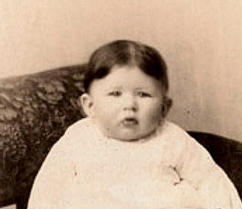
Katharine Wright in 1875, age 1 year.
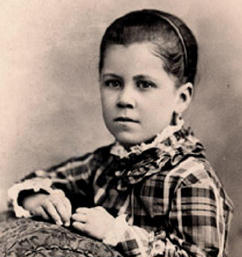
Katharine in 1879 at age 5, just before
entering elementary school
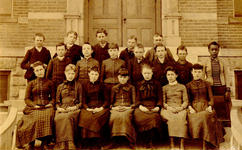
Katharine and her fifth grade class in 1884.
Katharine is in the first row, second from the right.
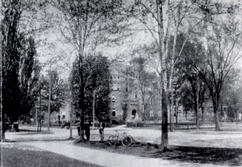
Oberlin College at the turn of the twentieth
century.
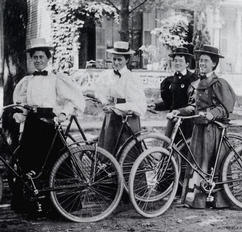
A bicycle outing in Oberlin. Katharine is in the front row wearing a
coat.
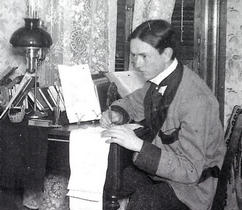
Harry Haskell (right) being his studious self in Oberlin.
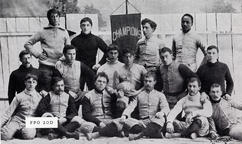
Arthur Cunningham was also a football
player for Oberlin College. He's in the middle row, second from the
left.
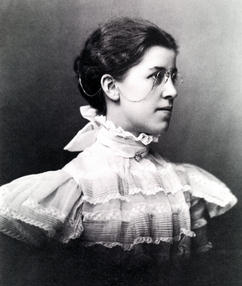
Katharine's portrait upon graduating from Oberlin in 1898.
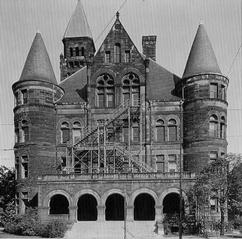
Steele High School in Dayton, Ohio in 1899. It was on Monument Street,
overlooking the Great Miami River.
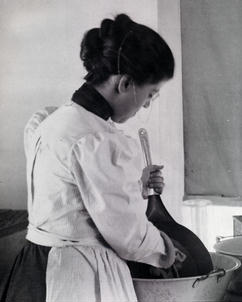
Katharine doing the dishes at 7 Hawthorne Street about 1900.
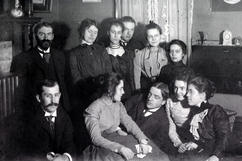
A party at 7 Hawthorn Street. Katharine in
right-most on the front row, talking with her friends. Orville
is left-most looking ill at ease.
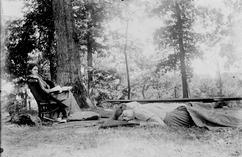
A camping trip, north of Dayton, in 1899. Katharine is sleeping while
her friend Harriet Silliman reads. Orville, who was along for the trip,
is probably taking the photo. While this outing was in progress,
Wilbur
conducted his famous kite experiment back in Dayton, rolling the kite in
the air by warping its wings.
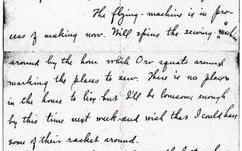
A letter from Katharine to Milton, describing the progress of the 1902
Wright Glider.
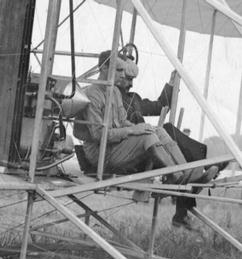
Orville (right) about to take off from Fort Myer with Lt. Thomas
Selfridge (left).
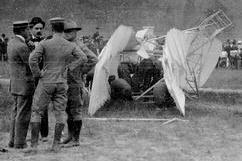
The aftermath of the crash in which Orville was injured and Lt.
Selfridge killed.
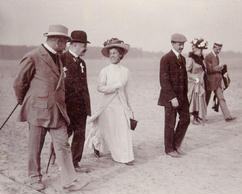
Katharine charms Lord Northcliffe (left), a British newspaper magnate.
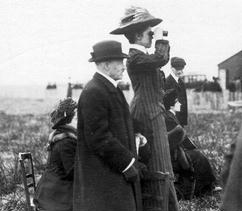
Katharine watching Wilbur Fly in Pau.
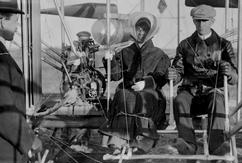
Katharine ready to take off with Wilbur in Pau. Orville is on the left.
Note the string around Katharine's skirt.
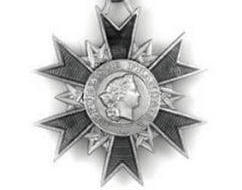
Upon leaving France, the French awarded Katharine
and her brothers the
Ordre national de la Légion d'honneur.
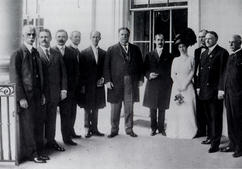
Katharine stands out in a white dress with her brothers and President
Taft (center) at the White House.
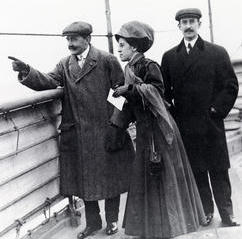
Katharine, Orville, and a passenger on their way to Germany in 1910.
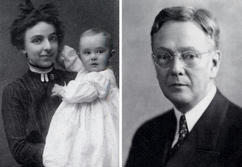
Harry Haskell (right) a few years before he met Katharine in Washington
DC. On the left is his wife Isabella and son Henry.
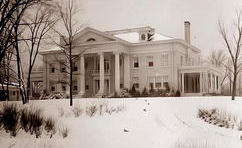
Hawthorne Hill in 1914 just after the Wrights moved in.
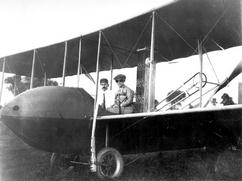
Katharine about to take a ride with Orville in a Wright Model H in 1915.
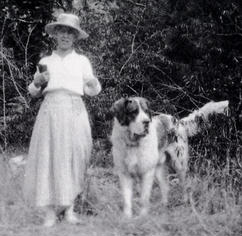
Katharine and Scipio on Lambert Island about 1920. To visit Lambert
Island on Google Earth,
CLICK HERE.
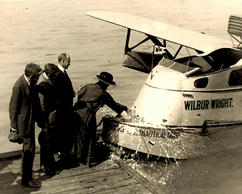
Katharine christens a flying boat, the
Wilbur Wright, in 1922. The aircraft had been designed by Grover
Loening, an engineer that once worked for the Wright Company.
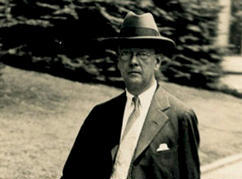
Harry Haskell visiting Hawthorn Hill in 1924.
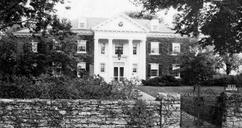
Harry and Katharine Haskell's home in Kansas City.
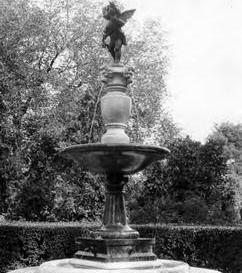
Katharine's fountain at Oberlin College when it was completed in 1933.
To visit the fountain on Google Earth,
CLICK HERE. To visit the original Fountain of Palazzo Vecchio in
Florence, Italy,
CLICK HERE.
|